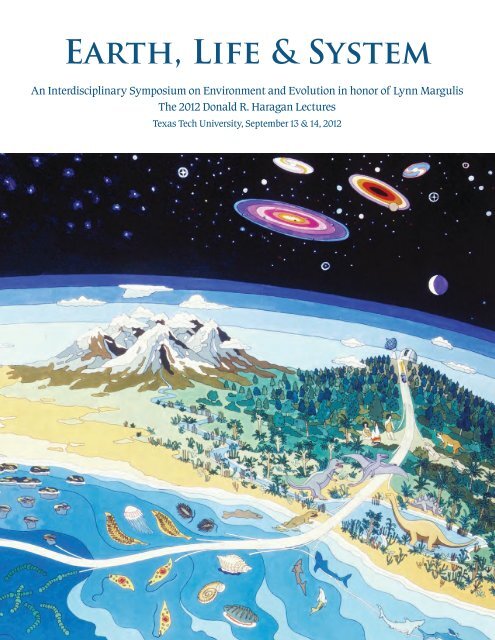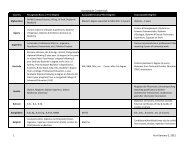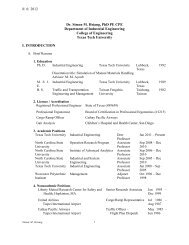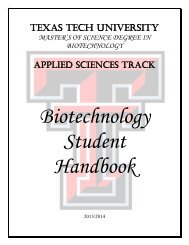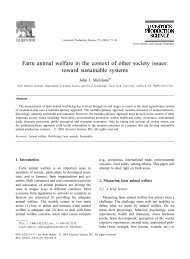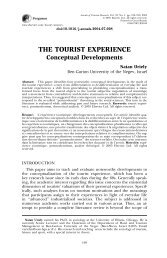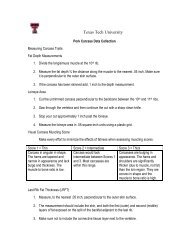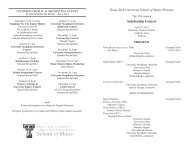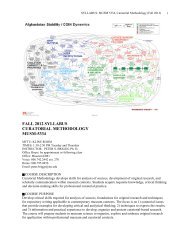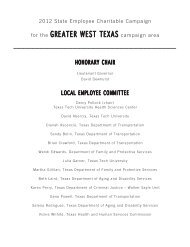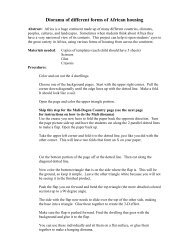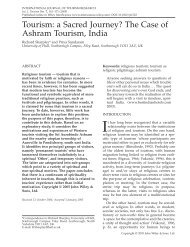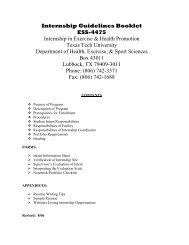Earth, Life & System - Texas Tech University
Earth, Life & System - Texas Tech University
Earth, Life & System - Texas Tech University
Create successful ePaper yourself
Turn your PDF publications into a flip-book with our unique Google optimized e-Paper software.
<strong>Earth</strong>, <strong>Life</strong> & <strong>System</strong><br />
An Interdisciplinary Symposium on Environment and Evolution in honor of Lynn Margulis<br />
The 2012 Donald R. Haragan Lectures<br />
<strong>Texas</strong> <strong>Tech</strong> <strong>University</strong>, September 13 & 14, 2012
Cover Image: Cosmic Evolution as depicted by the Exobiology program at NASA Ames Research Center, 1986.
<strong>Earth</strong>, <strong>Life</strong> & <strong>System</strong><br />
An Interdisciplinary Symposium on Environment and Evolution in honor of<br />
Lynn Margulis<br />
The 2012 Donald R. Haragan Lectures<br />
<strong>Texas</strong> <strong>Tech</strong> <strong>University</strong><br />
September 13 & 14, 2012<br />
McKenzie-Merket Alumni Center, 17th & <strong>University</strong>, Lubbock, TX<br />
Directors:<br />
Bruce Clarke, Department of English<br />
Michael San Francisco, Office of the Vice President for Research, and<br />
Biological Sciences<br />
Sponsored by:<br />
The College of Arts and Sciences<br />
Office of the Vice President for Research<br />
The Transdisciplinary Academy<br />
Sigma Xi at TTU<br />
CISER: The Center for the Integration of Science Education and Research<br />
The Haragan Lecture Series<br />
This event is co-sponsored by the TTU/HHMI Science Education Program @<br />
CISER and the President Donald R. Haragan Lecture Series Endowment, begun<br />
in 2001 in recognition of Dr. Haragan’s unparalleled, distinguished service to<br />
<strong>Texas</strong> <strong>Tech</strong> <strong>University</strong>.<br />
I N T R O D U C T I O N 1
Program<br />
Moderator: Manuela Rossini, Institute of Advanced Study in the Humanities<br />
and the Social Sciences, <strong>University</strong> of Bern, Switzerland<br />
Symposium at a Glance<br />
Thursday, September 13<br />
8:45-10:15 a.m. Sankar Chatterjee, Horn Professor, Department of Geosciences,<br />
Curator of Paleontology, TTU: “Meteoritic Impacts and the Endoprebiotic Origin<br />
of <strong>Life</strong>”<br />
10:30 a.m.-12:00 noon. Susan Squier, Julia Brill Professor of Women’s Studies<br />
and English, Pennsylvania State <strong>University</strong>: “The ‘World Egg’ Reconsidered:<br />
Waddington, Margulis, and Feminist New Materialism”<br />
1:00-2:30 p.m. Jan Sapp, Professor of Biology and History, York <strong>University</strong>: “On<br />
the Origins of Biological Kingdoms and Domains”<br />
2:45-4:15 p.m. J. Baird Callicott, <strong>University</strong> Distinguished Research Professor,<br />
Philosophy and Religion Studies, <strong>University</strong> of North <strong>Texas</strong>: “Gaia and the<br />
History of the Biosphere Concept”<br />
4:30-6:00 p.m. Dorion Sagan, Writer, Amherst, MA: “The World According to<br />
Margulis: An Abecedarium”<br />
6:00-7:30 p.m. Public Reception, McKenzie-Merket Alumni Center Courtyard<br />
2<br />
P R O G R A M
Friday, September 14<br />
8:45-10:15 a.m. Bruce Clarke, Horn Professor of Literature and Science,<br />
Department of English, TTU: “The Planetary Imagination”<br />
10:30 a.m.-12:00 noon. James A. Shapiro, Professor of Biochemistry and<br />
Molecular Biophysics, <strong>University</strong> of Chicago: “Bringing Cell Action into<br />
Evolution”<br />
1:00-2:30 p.m. James E. Strick, Associate Professor of Science, <strong>Tech</strong>nology and<br />
Society, Franklin & Marshall College: “The Serial Endosymbiosis and Gaia<br />
Theories: Their Incubation in NASA’s Exobiology Program and Diverse<br />
Cultural Valences”<br />
2:45-4:15 p.m. Susan Oyama, Professor Emerita of Psychology, John Jay<br />
College and the Graduate Center, CUNY: “Sustainable Development: Alternative<br />
Pathways in Developmental <strong>System</strong>s Theory”<br />
4:30-6:00 p.m. Peter Westbroek, Emeritus Professor of Geophysiology, Leiden<br />
<strong>University</strong>, Royal Netherlands Academy of Sciences and Arts: “Coming to Terms<br />
with Global Change: <strong>Tech</strong>nology is Not Enough”<br />
P R O G R A M<br />
3
Abstracts<br />
Thursday, September 13<br />
8:45-10:15 a.m. Sankar Chatterjee, “Meteoritic Impacts and the Endoprebiotic<br />
Origin of <strong>Life</strong>”<br />
There are two distinct processes for the origin of life: exogenous delivery of bio-<br />
molecules from space and endogenous synthesis of life on <strong>Earth</strong>. There is<br />
growing evidence that raining meteorites deposited building blocks of life<br />
and created the hydrothermal vent systems where primordial protocells were<br />
synthesized during the harsh, inhospitable, Late Heavy Bombardment Period<br />
(~4 to 3.8 billion years ago). Both comets and asteroids played roles in the<br />
prebiotic origin of life. Comets carried and deposited water and key ingredients<br />
of life from space to this planet, which were then concentrated and polymerized<br />
in crater basins created by the asteroids. The first forms of cellular life required<br />
self-assembled membranes that were followed by simultaneous emergence<br />
of polynucleotides and polypeptides. We suggest that the primordial<br />
polynucleotides and polypeptides that accumulated in mineral substrates of<br />
vent environments were the precursors to viruses and prions. Once the<br />
membranes encapsulated these simple RNA and protein molecules, they began<br />
to interact and initiate serial endoprebiosis, leading to hierarchical emergence of<br />
cell components including the plasma membrane, ribosome, and retrovirus, and<br />
finally, DNA. Proto-viruses and proto-prions performed two critical functions<br />
of a primitive cell, replication and metabolism respectively, which are similar<br />
to those of cellular function. Viruses and prions may represent evolutionary<br />
heirlooms of a microbial world that predated the appearance of the first cells.<br />
10:30 a.m.-12:00 noon. Susan Squier, “The ‘World Egg’ Reconsidered:<br />
Waddington, Margulis, and Feminist New Materialism”<br />
This paper takes as its text C. H. Waddington’s image of the “World Egg” from<br />
a talk he gave in 1967 at the Second Serbelloni Symposium, “Towards a<br />
Theoretical Biology.” The metaphor of the World Egg embodies Waddington’s<br />
signature concept of epigenetics. Whether viewed as unsettling and sinister<br />
4<br />
A B S T R A C T S
or as engaging and familiar, this image marks the interwoven and contrasting<br />
theories of biology of Waddington and Lynn Margulis. Moving from epigenesis,<br />
a concept from the developmental biology of Waddington, to prototaxis, a<br />
concept from the endosymbiotic work of Margulis, and finally to bioanalysis,<br />
a concept put forth by Elizabeth Wilson, I will argue that when Waddington’s<br />
epigenetics is read through the work of Margulis, it has useful implications for<br />
contemporary feminist theory. Although mainstream biology operationalized<br />
his concept primarily as a narrowly statistical analysis of the mechanisms of<br />
gene expression, it can also be read bioanalytically as a model of biological<br />
development that anticipates symbiogenesis and now activates the research<br />
of such feminist new materialist scholars as Karen Barad, Jane Bennett, and<br />
Elizabeth Wilson.<br />
1:00-2:30 p.m. Jan Sapp, “On the Origins of Biological Kingdoms and<br />
Domains”<br />
Neo-Darwinian evolutionary biology of the last century said nothing of the<br />
evolution of microorganisms, yet this is where the great diversity and great<br />
kingdoms of life lay hidden. Throughout most of the 20th century, discussions<br />
of kingdoms took place close to the margins of biology. Microbiology developed<br />
without an evolutionary context and mainly as an applied science associated<br />
with the study of disease. Based on classical comparative morphology, a<br />
phylogenetic understanding of bacterial taxa, long sought by some<br />
microbiologists, was deemed to be impossible. It was not until the last<br />
two decades of the twentieth century that biologists, led by Carl Woese,<br />
developed new molecular methods and concepts to investigate early microbial<br />
evolution with the aim of creating a universal phylogenetic tree. Those methods and<br />
concepts led to a taxonomic proposal of three domains representing three<br />
fundamental lineages of life, thus confronting the classical prokaryote-eukaryote<br />
dichotomy with an entirely different schema. That view of life also came<br />
to confront a five-kingdom system first proposed by Robert Whittaker and<br />
developed and championed by Lynn Margulis. My talk will survey<br />
A B S T R A C T S 5
the development of these new phylogenetic concepts and the subsequent controversy<br />
over the domains and kingdoms to which they give rise, in the context of<br />
molecular phylogenetic evidence, considered by both Woese and Margulis,<br />
that horizontal gene transfer and symbiosis are major modes of evolutionary<br />
innovation.<br />
2:45-4:15 p.m. J. Baird Callicott, “Gaia and the History of the Biosphere<br />
Concept”<br />
In 1875, after organizing geology into the lithosphere, the baryosphere (aka<br />
the hydrosphere), and the atmosphere, Eduard Suess coined and defined the<br />
“biosphere” as “the place on <strong>Earth</strong>’s surface where life dwells.” Vladimir<br />
Vernadsky featured the concept by making the biosphere a geological force—<br />
according to Lynn Margulis, “not a but the geological force”—physically and<br />
chemically transforming not only the atmosphere and hydrosphere, but also the<br />
crustal zone of the lithosphere. Independently of Vernadsky, Aldo Leopold anticipated<br />
the Gaia Hypothesis, speculating that the <strong>Earth</strong> itself is a living planet, with<br />
metabolic and physiologic properties, and possibly a soul or consciousness—and<br />
therefore an appropriate object of ethical respect. Vernadsky borrowed the term<br />
“noösphere” from Edouard LeRoy and Pierre Teilhard de Chardin, but—in contrast<br />
to them and to Leopold— conceived of it materially: as electronically linked<br />
human brains and the corpus of scientific knowledge thus generated, technologically<br />
applied in furthering the age-old work of living matter. The biosphere crossed<br />
the Atlantic via Vernadsky’s son George, a Yale professor of Russian history, and<br />
took root in the brain of Yale ecologist G. E. Hutchinson, who ecologized it. Lovelock’s<br />
Gaia was but a personification of Vernadsky’s biosphere—with, however,<br />
a focus more on its cybernetic than its metabolic character. Albeit collaborating<br />
with Lovelock in developing Gaia Theory, Margulis sided more with Vernadsky<br />
in conceiving of biospherical Gaia in biogeochemical terms and with Hutchinson<br />
in conceiving of biospherical Gaia as a superecosystem, not a superorganism, to<br />
which she attributed a proprioceptive sentience but not a robust consciousness.<br />
6<br />
A B S T R A C T S
4:30-6:00 p.m. Dorion Sagan, “The World According to Margulis: An<br />
Abecedarium”<br />
Lynn Margulis was one of the great scientists of the 20th century. Her core work<br />
on endosymbiosis was originally marginalized, but is now accepted and continues<br />
to unfold. I worked with her for over thirty years as her closest continuous<br />
collaborator in divulging her ideas to the public. Here I develop a preliminary<br />
summary of some of the high points and implications of her work. I will not<br />
attempt to be comprehensive; rather, I will focus on specific topics, alphabetically<br />
arranged, that reflect her overarching concerns. A is for Autopoiesis, which<br />
indicates her appreciation of an abstraction of a crucial aspect of life, more basic<br />
than reproduction and having to do with informational and causal closure, of which<br />
metabolism is the biological instantiation. Bacteria reflects on our preliminary<br />
deconstructive move, raising life’s earliest forms to pride of place on the basis<br />
of seniority, a reversal of the usual hierarchy that places man at top. Chimerism,<br />
Disease, Ecology, Feminism, Gaia, Hybridism, Internship, Journeying, Karyotypes,<br />
Liminality, Mixotricha, Neodarwinism, Organisms, Perception, Questioning,<br />
Religion, Symbiogenetics, Thermodynamics, Undulations, Values, Xenophilia,<br />
YouTube, and Zoology round out this alphabetical foray into Margulis’s world.<br />
6:00-7:30 p.m. Public Reception, McKenzie-Merket Alumni Center Courtyard<br />
Friday, September 14<br />
8:45-10:15 a.m. Bruce Clarke, “The Planetary Imagination”<br />
I will set forward the planetary imagination as a concept mediating literature<br />
and science. It occurs whenever an artist invents a planet, places it in a corresponding,<br />
perhaps imaginary cosmos, and bodies that construction forth<br />
in some workable medium. I will discuss the novels Solaris and Dune in this<br />
light. But it can also occur whenever the state and dynamics of the actual <strong>Earth</strong><br />
and its observation are rendered in detailed descriptions that possess scientific<br />
heft. Gregory Bateson’s ecology of mind and Margulis and Sagan’s discourse<br />
on Gaia will be our primary examples here. What will be of particular<br />
significance about specific instances of the planetary imagination are the<br />
A B S T R A C T S 7
models of knowing they convey—or again, the epistemological issues they put<br />
into play. A fully planetary imagination of the <strong>Earth</strong> observes a coupled and<br />
co-evolving metasystem of environment and life, an object far transcending the<br />
human. This faculty is especially significant, then, as a mode of observation that<br />
undercuts or goes beyond its own capacity to observe, and in which the theoretical<br />
construction of a planetary body for artistic, discursive, or scientific ends, for that<br />
very reason, intends to decenter the human in relation to its worldly situation.<br />
10:30 a.m.-12:00 noon. James A. Shapiro, “Bringing Cell Action into Evolution”<br />
Lynn Margulis was an indefatigable advocate of positive cell action in<br />
the evolutionary process. Lynn focused her work on observing real-time<br />
interactions between cells and advocating the major role of cell fusions and<br />
symbiogenesis in rapid evolutionary change. Confirmation of the mitochondrion<br />
and chloroplast in eukaryotic cells as descendants of well-defined prokaryotes<br />
was a major turning point away from the gradualist ideology that<br />
dominated evolutionary thinking for most of the 20th Century. Since then, we<br />
have come to appreciate more the major evolutionary roles of cell-cell interactions<br />
and cellular control of genome structure. The well-established phenomena<br />
of symbiosis, hybridization, horizontal DNA transfers, genome repair, and<br />
natural genetic engineering have revolutionized our understanding of genome<br />
variation. Rather than a series of accidents randomly changing a ROM (read-only<br />
memory) heredity system, we realize that active cell processes non-randomly restructure<br />
a RW (read-write) genomic storage system at all biological time scales.<br />
1:00-2:30 p.m. James E. Strick, “The Serial Endosymbiosis and Gaia Theories:<br />
Their Incubation in NASA’s Exobiology Program and Diverse Cultural Valences”<br />
Both the Gaia hypothesis and the Serial Endosymbiosis Theory developed in and<br />
were funded by the NASA Exobiology Program first begun in 1960. This paper<br />
will explore the ways in which that program served as both crucial intellectual and<br />
financial support for each theory. Given prejudices about NASA science in the wider<br />
research community, this context also conditioned some of the skepticism with<br />
which both theories were initially received. A range of other implications of the<br />
theories is explored here, including the cultural valences that sometimes resulted<br />
8<br />
A B S T R A C T S
from the nature of the theories themselves and the cultural moment in which they<br />
appeared.<br />
2:45-4:15 p.m. Susan Oyama, “Sustainable Development: Alternative Pathways<br />
in Developmental <strong>System</strong>s Theory”<br />
“Sustainable development” is intentionally ambiguous; much of the talk is about<br />
multiple meanings within and outside biology. The developmental analog of that<br />
multiplicity is flexibility, whose importance in evolution will be explored. Some<br />
key terms will also get attention, including transmission, construction, interaction,<br />
and contingency. Contingency is often associated with chance or randomness, but<br />
the operative meaning here is causal dependency. Organisms are ontogenetically<br />
contingent; countless dependencies can be studied within the skin and extending<br />
out beyond it to an indefinite series of conditions and processes that are themselves<br />
contingent on other factors. Yet these densely interlocked and variable complexes<br />
can generate both the variation and the stability and recurrence needed for evolution.<br />
The discussion concludes with a consideration of sustainable development,<br />
intended not only in its usual contexts of agriculture and economic growth, but<br />
also in developmental and evolutionary studies. It is both possible and satisfying<br />
to see such regularity, when it occurs, in terms of interconnected systems of<br />
contingent influences. These last include symbiotic associations, among the most<br />
sustained, and sustaining, examples of long-term resource management we have.<br />
4:30-6:00 p.m. Peter Westbroek, “Coming to Terms with Global Change: <strong>Tech</strong>nology<br />
is Not Enough“<br />
The multifarious problems of Global Change are overwhelmingly addressed in<br />
terms of management solutions through technological innovations. However, what<br />
the policy makers seem to forget is the greatest problem of all – the public disorientation<br />
and anxiety that global problems arouse. One may speak of a lingering, chronic<br />
and uncontrolled panic in large sectors of the population, already showing its ugly<br />
face in outbreaks of intolerance, fundamentalism, nationalism, and xenophobia.<br />
Instead of reacting responsibly and in concert, many people tend to take refuge in<br />
entirely counterproductive attitudes. Sadly, the great scientific programs of Global<br />
Change, for example, by the Intergovernmental Panel on Climate Change (IPPC),<br />
A B S T R A C T S 9
tend not to diminish, but to intensify this tendency. Their short-term, century-scale<br />
perspective precludes unambiguous predictions and leaves ample room for confusion.<br />
Meanwhile, matters of public orientation are left to the free play of religious<br />
and other ideological forces, while science may only correct erroneous viewpoints,<br />
but is not thought to give rise to a coherent worldview by itself. In this paper, I shall<br />
argue that <strong>Earth</strong> <strong>System</strong> Science, with its perspective of global history over fortysix<br />
million centuries, is capable of inducing a new worldview, a universal, realitycongruent<br />
public orientation, essential for a proper response to Global Change.<br />
10<br />
A B S T R A C T S
Biographies<br />
J. Baird Callicott is <strong>University</strong> Distinguished Research Professor of Philosophy<br />
and formerly Regents Professor of Philosophy at the <strong>University</strong> of North <strong>Texas</strong>.<br />
Callicott completed his MA (1966) and PhD (1972) in philosophy at Syracuse<br />
<strong>University</strong>. In 1969, he joined the philosophy department at the <strong>University</strong> of Wisconsin-Stevens<br />
Point, where he taught the world’s first course in environmental<br />
ethics in 1971. He is co-Editor-in-Chief of the Encyclopedia of Environmental<br />
Ethics and Philosophy and author or editor of a score of books and author of dozens<br />
of journal articles, encyclopedia articles, and book chapters in environmental<br />
philosophy and ethics. Callicott has served as president of the International Society<br />
for Environmental Ethics, as Bioethicist-in-Residence at Yale <strong>University</strong>, and<br />
the UNT Department of Philosophy and Religion Studies as chair. His research<br />
goes forward on four main fronts: theoretical environmental ethics; comparative<br />
environmental ethics and philosophy; the philosophy of ecology and conservation<br />
policy; and biocomplexity in the environment, coupled natural and human systems<br />
(sponsored by the National Science Foundation). Callicott is perhaps best known<br />
as the leading contemporary exponent of Aldo Leopold’s land ethic and is currently<br />
exploring an Aldo Leopold <strong>Earth</strong> ethic in response to global climate change.<br />
His teaching at UNT includes graduate and undergraduate courses in ancient<br />
Greek philosophy and ethical theory, in addition to environmental philosophy.<br />
Sankar Chatterjee is Paul Whitfield Horn Professor of Geology and Curator of<br />
Paleontology at the Museum of <strong>Texas</strong> <strong>Tech</strong> <strong>University</strong>. He led several expeditions<br />
to India, China, Antarctica, and the American Southwest in search of dinosaurs and<br />
early birds and has discovered, named, and described several new taxa. His current<br />
research focuses on Mesozoic vertebrates, flight of pterosaurs and birds, origin of<br />
flight, mass extinction, macroevolution, plate tectonics, and paleobiogeography.<br />
His work on macroevolution encompasses the study of large-scale patterns of evolution<br />
above the species level, and mass extinctions and their long-term consequences<br />
in biodiversity. He has published more than 100 scientific papers and three<br />
books, including New Concepts in Global Tectonics (1992, co-edited with Nicholas<br />
Hotton), The Rise of Birds (1997), and Posture, Locomotion, and Paleoecology<br />
of Pterosaurs (2004, with R. J. Templin). His work on animal flight and Shiva<br />
B I O G R A P H I E S 11
crater received national and international media coverage. With Richard Lind he is<br />
currently designing a pterodactyl-inspired drone, a robotic spy plane to master air,<br />
ground, and sea. Chatterjee has received numerous awards in recognition of his distinguished<br />
and continuing achievements in original research including the Antarctic<br />
Service Medal, Scientist of the Year (Achievement Rewards for College Scientists),<br />
L. Rama Rao Birth Centenary Award (Geological Society of India), Elected<br />
Fellow (Geological Society of America and American Association of Advancement<br />
of Sciences), Honorary Member (Golden Key National Honor Society), Best Research<br />
Scientist (<strong>Texas</strong> <strong>Tech</strong> <strong>University</strong>), and Best Bengali Scientist (Star Ananda).<br />
Bruce Clarke is the Paul Whitfield Horn Professor of Literature and Science in<br />
the Department of English at <strong>Texas</strong> <strong>Tech</strong> <strong>University</strong>. His book publications are<br />
Allegories of Writing: The Subject of Metamorphosis (1995), Dora Marsden and<br />
Early Modernism: Gender, Individualism, Science (1996), Energy Forms: Allegory<br />
and Science in the Era of Classical Thermodynamics (2001), and Posthuman<br />
Metamorphosis: Narrative and <strong>System</strong>s (2008). He has co-edited From Energy<br />
to Information: Representation in Science and <strong>Tech</strong>nology, Art, and Literature<br />
(2002), Emergence and Embodiment: New Essays in Second-Order <strong>System</strong>s Theory<br />
(2009), and the Routledge Companion to Literature and Science (2010; paperback,<br />
2012). His manuscript Narrative, Media, <strong>System</strong>s, developing systems<br />
theory as a matrix of operations for narrative and media theory, is currently submitted.<br />
His ongoing book project is <strong>System</strong>s Countercultures, examining American<br />
systems discourses since the Whole <strong>Earth</strong> Catalog. With Henry Sussman he<br />
edits the book series Meaning <strong>System</strong>s, published by Fordham <strong>University</strong> Press.<br />
Susan Oyama trained at Harvard <strong>University</strong> and is now Professor Emeritus at<br />
the John Jay College of Criminal Justice and the Graduate School and <strong>University</strong><br />
Center (both of the City <strong>University</strong> of New York). She has written widely<br />
on the nature/nurture opposition and on the concepts of development, evolution,<br />
and genetic information. With others, she wrote and edited Aggression (1988),<br />
under the pen name John Klama, but is best known for her work on Developmental<br />
<strong>System</strong>s Theory, to which many were introduced by her 1985 book, The<br />
Ontogeny of Information: Developmental <strong>System</strong>s and Evolution. An expanded<br />
edition of that work appeared in 2000, along with Evolution’s Eye: A<br />
12<br />
B I O G R A P H I E S
<strong>System</strong>s View of the Biology-Culture Divide. With Paul Griffiths and Russell<br />
Gray, Oyama edited Cycles of Contingency, a volume of papers on developmental<br />
systems by scholars from many fields. She is especially interested in the role of<br />
theory in transdisciplinary relations.<br />
Manuela Rossini holds an MA in English and Spanish Philology from the<br />
<strong>University</strong> of Basel and an MA in Critical and Cultural Theory from the<br />
<strong>University</strong> of Cardiff. She did her PhD at the <strong>University</strong> of Basel on the family<br />
in early modern drama and culture. A postdoctoral scholarship from the Swiss<br />
National Science Foundation took her to the Netherlands for six years before she<br />
returned to Switzerland in 2008 to work for the Transdisciplinary Network (tdnet)<br />
of the Swiss Academies of Arts and Sciences, and, since 2009, as the coordinator<br />
of the Graduate School of the Institute of Advanced Study in the Humanities<br />
and the Social Sciences at the <strong>University</strong> of Bern, Switzerland. She is<br />
also the Executive Director and Vice President of the European Society for Literature,<br />
Science and the Arts (SLSA-Europe). She edits the Rodopi book series<br />
Experimental Practices. Her research interests include inter- and transdisciplinarity,<br />
posthumanism, animal studies, and feminism. Her recent books and editions<br />
include From House to Home: Family Matters in Early Modern Drama and<br />
Culture (2009), Animal Encounters (2009), The Routledge Companion to<br />
Literature and Science (2010); and Energy Connections (2011).<br />
Dorion Sagan worked closely with Lynn Margulis for over 30 years, coauthoring<br />
works such as Microcosmos, What is <strong>Life</strong>?, and Dazzle Gradually. Author or coauthor<br />
of twenty-four books translated into eleven languages, Sagan’s works include<br />
Death and Sex—winner of the Bookbinder’s Guild of New York 2009 award for<br />
best nonfiction hardcover—and Into the Cool, a sustained track on the thermodynamics<br />
of life with a chapter on life’s natural purpose. Sagan has lectured widely,<br />
including at the American Museum of Natural History, the Smithsonian Institution,<br />
the Artist’s Institute in Manhattan, and in Xi’an, China. His writings have<br />
appeared in the New York Times, the New York Times Book Review, Wired, and<br />
Cabinet. His most recent projects include Lynn Margulis: The <strong>Life</strong> and Legacy of<br />
a Scientific Rebel, a book of essays with contributions from, among others, David<br />
Abram, David Ray Griffin, and Niles Eldridge, and Cosmic Apprentice: Dispatches<br />
from the Edges of Science, forthcoming from the <strong>University</strong> of Minnesota Press.<br />
B I O G R A P H I E S 13
Jan Sapp is professor in the Department of Biology at York <strong>University</strong> in<br />
Toronto, Canada. He received his PhD in the history of science from the<br />
<strong>University</strong> of Montréal in 1984. He subsequently held an appointment at the<br />
<strong>University</strong> of Melbourne for eight years, where he also served as chair of the<br />
Department of History and Philosophy of Science. He was Andrew Mellon<br />
Fellow at the Rockefeller <strong>University</strong>, 1991-92. He held the Canada Research<br />
Chair in the History of the Biological Sciences at the <strong>University</strong> of Québec at<br />
Montréal from 2001-03 before returning to York <strong>University</strong>, where he has been<br />
a professor since 1992. His writings focus especially on evolutionary biology<br />
and ecology, emphasizing the fundamental importance of symbiosis and<br />
horizontal gene transfer in heredity and evolution. He is the author of numerous<br />
papers and several books, including Beyond the Gene (1987), Where The<br />
Truth Lies (1990), Evolution by Association: A History of Symbiosis (1994), What<br />
is Natural? Coral Reef Crisis (1999), Genesis: The Evolution of Biology<br />
(2003), an edited volume on Microbial Phylogeny and Evolution: Concepts<br />
and Controversies (2005), and, more recently, The New Foundations of Evolution:<br />
On the Tree of <strong>Life</strong> (2009).<br />
James A. Shapiro is Professor of Microbiology at the <strong>University</strong> of Chicago.<br />
He has a BA in English Literature from Harvard (1964) and a PhD in Genetics<br />
from Cambridge (1968). His thesis, The Structure of the Galactose Operon<br />
in Escherichia coli K12, contains the first suggestion of transposable elements<br />
in bacteria. He confirmed this hypothesis in 1968 during his postdoctoral tenure<br />
in the laboratory of Francois Jacob at the Pasteur Institute in Paris. In Jonathan<br />
Beckwith’s laboratory at Harvard Medical School the following year, he and his<br />
colleagues used in vivo genetic manipulations to clone and purify the lac operon<br />
of E. coli, an accomplishment that received international attention. In 1979,<br />
Shapiro formulated the first precise molecular model for transposition and<br />
replication of phage Mu and other transposons. Since 1992, he has been<br />
writing about the importance of biologically regulated natural genetic engineering<br />
as a fundamental new concept in evolution science. He is editor of DNA Insertion<br />
Elements, Episomes and Plasmids (1977 with Bukhari and Adhya), Mobile<br />
Genetic Elements (1983), and Bacteria as Multicellular Organisms (1997<br />
with Martin Dworkin). He has been a leading scientific critic of orthodox<br />
14<br />
B I O G R A P H I E S
evolutionary theory for 20 years and received an honorary O.B.E. from Queen<br />
Elizabeth for services to higher education in the UK and US.<br />
Susan Merrill Squier is Brill Professor of Women’s Studies and English<br />
at Penn State <strong>University</strong>. She is the author or editor of eight books, including<br />
Babies in Bottles: Twentieth-Century Visions of Reproductive <strong>Tech</strong>nology (1984),<br />
Liminal Lives: Imagining the Human at the Frontiers of Biomedicine (2004),<br />
and Poultry Science, Chicken Culture: A Partial Alphabet (2011). She was<br />
scholar in residence at the Bellagio Study and Conference Center (2001);<br />
Visiting Distinguished Fellow, LaTrobe <strong>University</strong>, Melbourne, Australia;<br />
and Fulbright Senior Research Scholar, Melbourne, Australia. She is Advisory<br />
Board Member of SymbioticA Biological Arts (Perth) and of the Society<br />
for Literature, Science, and the Arts. She co-directed an NEH Institute<br />
on “Medicine, Literature and Culture” at the Penn State College of Medicine,<br />
Hershey Medical Center. She co-organized three international conferences<br />
on comics and medicine: “Graphic Medicine” (London 2010), “Comics and<br />
Medicine: Sequential Art and Illness” (Chicago 2011), and “Graphic Medicine:<br />
Voices from the Margins” (Toronto 2012). She co-edits the Graphic Medicine<br />
book series at Penn State Press.<br />
James E. Strick is Associate Professor in the Program in Science, <strong>Tech</strong>nology<br />
and Society, and chair of the Department of <strong>Earth</strong> and Environment at Franklin<br />
and Marshall College in Lancaster, PA. Originally trained in microbiology, and<br />
later in history of science, Dr. Strick has published extensively on the history<br />
of ideas and experiments about the origin of life, including Sparks of <strong>Life</strong>:<br />
Darwinism and the Victorian Debates over Spontaneous Generation (2000)<br />
and, with Steven Dick, The Living Universe: NASA and the Development of<br />
Astrobiology (2004). He is also the editor of two six volume collections of<br />
primary sources: Evolution and the Spontaneous Generation Debate (2001) and<br />
The Origin of <strong>Life</strong> Debate: Molecules, Cells, and Generation (2004). Strick has<br />
been an advisory editor of ISIS and a member of the History of Science Society<br />
Council. He is currently at work on a book about Wilhelm Reich’s bion experiments<br />
on the origin of life, 1934-1939, under contract with Harvard <strong>University</strong> Press.<br />
B I O G R A P H I E S 15
Peter Westbroek is Emeritus Professor of Geophysiology at Leiden <strong>University</strong><br />
and a member of the Royal Netherlands Academy of Sciences and Arts. He<br />
occupied the European Chair of the Colege of France in 1996–97. Westbroek<br />
studied geology and did his PhD in fossil brachiopod paleobiology at Leiden<br />
<strong>University</strong> in the Netherlands. He then had a post-doctoral position at Queen’s<br />
<strong>University</strong> in Belfast, where he began biochemical research on biomineralization.<br />
In 1970 he started a small group in the Department of Biochemistry at Leiden<br />
<strong>University</strong>, with research on calcification in the coccolithophore Emiliania<br />
huxleyi, immunology of fossil macromolecules, and bacterial manganese and<br />
iron oxidation. Westbroek gave regular lecture courses on the influence of<br />
biological systems on <strong>Earth</strong> dynamics, and published <strong>Life</strong> as a Geological Force in<br />
1992. He started the Global Emiliania Modeling Initiative (GEM), an international<br />
and interdisciplinary project on the climatic effects of marine phytoplanton.<br />
He recently co-founded the Gaia Science Center. A book in English, Discovery of<br />
the <strong>Earth</strong>: Big History of a Small Planet, is forth coming.<br />
16<br />
B I O G R A P H I E S


